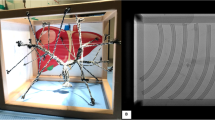Abstract
Purpose
Learning how to perform percutaneous transhepatic bile duct drainage (PTCD) is challenging for interventional radiology (IR) trainees. Therefore, simulators are crucial for IR training and are being increasingly demanded in the evolving healthcare environment of value-based care. To facilitate interventional training, we tried to evaluate our newly developed liver phantom for further use in IR training.
Methods
We developed a liver phantom with a flexible hollow biliary tree, hydrogel-based liver parenchyma, plastic ribs, and silicone skin. The phantom was evaluated by 20 radiology residents from two hospitals. After an introduction, all participants tried to obtain biliary access by fluoroscopic guidance within 25 min. Puncture time, fluoroscopy time, and kerma area product were measured. After 7 days, the participants repeated the procedure on an altered and more difficult model. Additionally, a survey was handed out to every participant (20 residents, 5 experts, and 5 IR fellows) to evaluate the phantom in terms of accuracy and haptic feedback, as well as general questions regarding simulation.
Results
The residents performed significantly faster and were more self-confident on Day 7 than on Day 1, significantly decreasing puncture time, fluoroscopy time, and kerma area product (p ≤ 0.0001). The participants were very satisfied with their simulation experience and would trust themselves more in real-life scenarios.
Conclusion
We were able to develop a phantom with high anatomical accuracy for fluoroscopy and ultrasound-guided interventions. The phantom successfully helped residents learn and improve their PTCD performance.







Similar content being viewed by others
References
Venkatanarasimha N, Damodharan K, Gogna A, Leong S, Too CW, Patel A, Tay KH, Tan BS, Lo R, Irani F. Diagnosis and management of complications from percutaneous biliary tract interventions. Radiographics. 2017;37:665–80. https://doi.org/10.1148/rg.2017160159.
Degiorgio S, Gerasia R, Liotta F, Maruzzelli L, Cortis K, Miraglia R, Luca A. Radiation doses to operators in hepatobiliary interventional procedures. Cardiovasc Interv Radiol. 2018;41(5):772–80. https://doi.org/10.1007/s00270-017-1870-3.
Miller ZA, Amin A, Tu J, Echenique A, Winokur RS. Simulation-based training for interventional radiology and opportunities for improving the educational paradigm. Tech Vasc Interv Radiol. 2019;22:35–40. https://doi.org/10.1053/j.tvir.2018.10.008.
Mirza S, Athreya S. Review of simulation training in interventional radiology. Acad Radiol. 2018;25:529–39. https://doi.org/10.1016/j.acra.2017.10.009.
Lopez Benítez R, Reyes del Castillo T, Benz D, et al. Percutaneous transhepatic biliary puncture simulator a cord network prototype. Adv Simul. 2021. https://doi.org/10.1186/s41077-021-00178-w.
Kaufmann R, Zech CJ, Takes M, et al. Vascular 3D printing with a novel biological tissue mimicking resin for patient-specific procedure simulations in interventional radiology: a feasibility study. J Digit Imaging. 2022;35(1):9–20. https://doi.org/10.1007/s10278-021-00553-z.
Patel R, Dennick R. Simulation based teaching in interventional radiology training: is it effective? Clin Radiol. 2017;72:266.e7-266.e14. https://doi.org/10.1016/j.crad.2016.10.014.
Arnolli MM, Buijze M, Franken M, de Jong KP, Brouwer DM, Broeders IAMJ. System for CT-guided needle placement in the thorax and abdomen: a design for clinical acceptability, applicability and usability. Int J Med Robot. 2018. https://doi.org/10.1002/rcs.1877.10.1002/rcs.1877.
Fortmeier D, Mastmeyer A, Schroder J, Handels H. A virtual reality system for PTCD simulation using direct visuo-haptic rendering of partially segmented image data. IEEE J Biomed Health Inform. 2016;20(1):355–66. https://doi.org/10.1109/jbhi.2014.2381772.
Mastmeyer A, Wilms M, Handels H. Interpatient respiratory motion model transfer for virtual reality simulations of liver punctures. arXiv preprint 2017 arXiv:1707.08554.
Villard PF, Vidal FP, Hunt C, et al. A prototype percutaneous transhepatic cholangiography training simulator with real-time breathing motion. Int J Comput Assist Radiol Surg. 2009;4(6):571–8. https://doi.org/10.1007/s11548-009-0367-1.
Mastmeyer A, Fortmeier D, Handels H. Evaluation of direct haptic 4D volume rendering of partially segmented data for liver puncture simulation. Sci Rep. 2017. https://doi.org/10.1038/s41598-017-00746-z.
Tan X, Li D, Jeong M, et al. Soft liver phantom with a hollow biliary system. Ann Biomed Eng. 2021;49(9):2139–49. https://doi.org/10.1007/s10439-021-02726-x.
Acknowledgements
The authors wish to thank all the participants, who trained and evaluated our simulator.
Funding
This study was not supported by any funding.
Author information
Authors and Affiliations
Contributions
CF designed the study and phantom. CF and TR collected the data and wrote the paper. CF edited and submitted the final paper. JR, CZ, MT and RL provided expertise and supervised the study. All authors have read and agreed to the published version of the manuscript.
Corresponding author
Ethics declarations
Conflict of interest
The authors declare that they have no conflict of interest.
Ethical Approval
All procedures performed in studies involving human participants were in accordance with the ethical standards of the institutional research committee and with the 1964 Helsinki declaration and its later amendments or comparable ethical standards.
Informed Consent
Informed consent was obtained from all individual participants included in the study.
Consent for Publication
Consent for publication was obtained for every individual person’s data included in the study.
Additional information
Publisher's Note
Springer Nature remains neutral with regard to jurisdictional claims in published maps and institutional affiliations.
Rights and permissions
Springer Nature or its licensor (e.g. a society or other partner) holds exclusive rights to this article under a publishing agreement with the author(s) or other rightsholder(s); author self-archiving of the accepted manuscript version of this article is solely governed by the terms of such publishing agreement and applicable law.
About this article
Cite this article
Fechner, C., Reyes del Castillo, T., Roos, J.E. et al. 3D Printed Percutaneous Transhepatic Cholangiography and Drainage (PTCD) Simulator for Interventional Radiology. Cardiovasc Intervent Radiol 46, 500–507 (2023). https://doi.org/10.1007/s00270-022-03347-0
Received:
Accepted:
Published:
Issue Date:
DOI: https://doi.org/10.1007/s00270-022-03347-0




